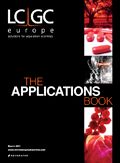Direct Determination of 2-Ethylhexanoic Acid in Clavulante
Dionex Application note
Richard Kornfeld, Brian De Borba and Jeffrey Rohrer, Dionex Corporation, Sunnyvale, California, USA.
Clavulanic acid is commonly used in combination with penicillin and cephalosporin antibiotics to overcome bacterial resistance. Clavulanic acid is produced and isolated from Streptomyces clavuligeru with ethyl acetate and then converted to a stable form. One secondary purification approach uses nonaqueous precipitation of potassium clavulanate by adding the potassium salt of 2-ethylhexanoic acid in isopropanol to the primary isolation extract. While 2-ethylhexanoic acid is soluble in the organic solvent, a small fraction may co-precipitate with the potassium clavulanate.
The United States Pharmacopeia (USP) monograph for potassium clavulanate describes a GC–FID method to determine 2-ethylhexanoic acid in the active pharmaceutical ingredient (API). This contribution describes a simpler approach for determining 2-ethylhexanoic acid in clavulanate with a Reagent-Free Ion Chromatography (RFIC) system. USP clavulanate reference standards were prepared at a 150-fold lower concentration in deionized water than the current USP method, spiked with 2-ethylhexanoic acid, and injected directly without additional sample pretreatment. The target analyte was separated from clavulanate-related peaks using electrolytically generated potassium hydroxide eluent and measured by suppressed conductivity detection.
Experimental
Analyses are performed using a Dionex ICS-2100 system, AS Autosampler, and Chromeleon Chromatography Data System. Separations use an IonPac AG11/AS11 column set (USP L61) with electrolytically generated KOH eluent.1
Results and Discussion
Figure 1 compares 500 µg/mL clavulanate with and without 2-ethylhexanoic acid spiked at the 0.8% acceptance criterion cutoff value specified in the USP monograph. As shown, 2-ethylhexanoic acid is separated in less than 10 min without any interference from minor components in the sample matrix. The method demonstrated good sensitivity with a low limit of detection (LOD) for 2-ethylhexanoic acid of 0.036 µg/mL, which corresponds to a concentration of 0.008% in the API. This represents a 100-fold lower concentration than the 0.8% acceptance criterion cutoff value in clavulanate. Results for linearity, spike recovery, retention time precision and peak area precision determinations show that IC is an accurate and reproducible technique to determine 2-ethylhexanoic acid in clavulanate below the 0.8% acceptance criterion. The lower LOD achieved by this method allows a 150-fold lower API concentration, thereby reducing cost. In addition, this proposed method eliminates the need for two solvent extractions required in the GC–FID method in the current USP monograph, thus significantly simplifying sample preparation, reducing waste and further improving cost efficiency.

Figure 1: Chromatographic comparison of clavulanate without (trace A) and with (trace B) 4 µg/mL (0.8%) 2-ethylhexanoic acid. Peak 1: 2-ethylhexanoic acid (4 µg/mL â 0.8%). Column: IonPac AG11/AS11 column set (USP L61).Eluent: 3 mM KOH from 0 to 10 min; 3â60 mM KOH from 10 to 10.1 min; 60 mM KOH from 10.1 to 20.1 min. Flow-rate: 0.25 mL/min. Temp: 30 °C. Inj. Vol: 5 µL. Detection: suppressed conductivity, ASRS 300 2 mm, recycle mode, 2 mA suppressor current during 3 mM KOH, switch to 38 mA at 10.1 min.
References
1. Dionex Corporation, Determination of 2-Ethylhexanoic Acid Impurity in Clavulanate Using a Reagent-Free Ion Chromatography System. Application Note 262, LPN 2608, (Oct., 2010).
Chromeleon and IonPac are registered trademarks and RFIC is a trademark of Dionex Corporation.

Dionex Corporation
1228 Titan Way, PO Box 3603, Sunnyvale, California 94088, USA
tel. +1 408 737 0700 fax +1 408 730 9403
Website: www.dionex.com

Separating Impurities from Oligonucleotides Using Supercritical Fluid Chromatography
February 21st 2025Supercritical fluid chromatography (SFC) has been optimized for the analysis of 5-, 10-, 15-, and 18-mer oligonucleotides (ONs) and evaluated for its effectiveness in separating impurities from ONs.

.png&w=3840&q=75)

.png&w=3840&q=75)



.png&w=3840&q=75)



.png&w=3840&q=75)


















